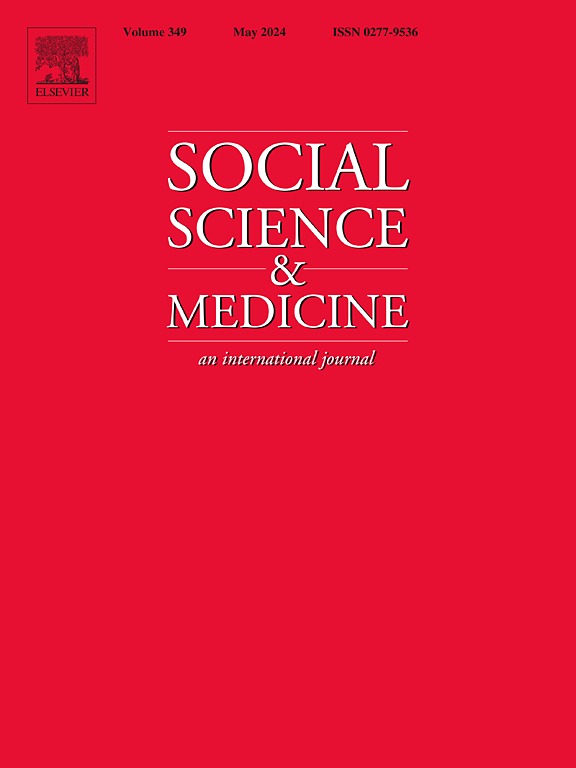性别对结直肠癌发病率的影响:考虑性别机制的影响
IF 4.9
2区 医学
Q1 PUBLIC, ENVIRONMENTAL & OCCUPATIONAL HEALTH
引用次数: 0
摘要
背景癌症(CRC)男性和女性发病率的差异有文献记载,但性别机制在解释这些差异中的作用仍有待进一步探讨。CRC是全球第三致命的癌症,通常通过“生物学”性别差异进行分析,而先天因素和社会后天因素之间没有明确区别。性别机制,包括社会角色、行为和获得医疗保健的机会,可能会显著影响CRC风险。目的本研究采用社会流行病学方法,量化性别机制对出生性别分配与CRC发病率之间关系的影响比例。方法利用CONSTANCES队列和法国国家健康保险数据库(SNDS)的数据,我们用有向无环图(DAG)确定了相关协变量。中介分析估计了社会经济、行为、人体测量和医疗因素作为性别相关机制的贡献。结果男性患CRC的风险高于女性(OR:1.54[1.33;1.79])。男性表现出较低的文化资本、较高的社会和经济资本、更频繁的风险行为和更高的BMI。在估算数据中,性别机制占出生时性别分配与CRC发病率之间关联的30%,在完整病例中高达50%。在性别机制中,BMI是主要的中介因素。结论本研究揭示,CRC发病率中基于性别的健康不平等部分是由社会和行为危险因素暴露的差异造成的。这些发现强调了将性别动态纳入CRC预防和干预的公共卫生战略的重要性,重点是解决基于性别的风险因素暴露问题。本文章由计算机程序翻译,如有差异,请以英文原文为准。
Influence of sex on the incidence of colorectal cancer: considering the influence of gender mechanisms
Context
Differences in colorectal cancer (CRC) incidence between men and women are documented, but the role of gender mechanisms in explaining these disparities remains underexplored. CRC, the third deadliest cancer worldwide, is often analyzed through “biological” sex differences, without a clear distinction between innate and socially acquired factors. Gender mechanisms, including social roles, behaviors, and access to healthcare, may significantly influence CRC risk.
Objective
This study quantifies the proportion of the effect of gender mechanisms on the relationship between sex assigned at birth and CRC incidence, adopting a social epidemiology approach.
Method
Using data from the CONSTANCES cohort and the French National Health Insurance database (SNDS), we identified relevant covariates with a Directed Acyclic Graph (DAG). Mediation analyses estimated the contribution of socioeconomic, behavioral, anthropometric and medical factors as gender-related mechanisms.
Results
Men have a higher risk of CRC compared to women (OR: 1.54 [1.33; 1.79]). Men exhibit lower cultural capital, higher social and economic capital, more frequent risk behaviors, and higher BMI. Gender mechanisms account for 30 % of the association between sex assigned at birth and CRC incidence, in the imputed data, and up to 50 % in the complete cases. Among the gender mechanisms, BMI emerged as the main mediator.
Conclusion
This study reveals that gender-based health inequalities in CRC incidence are partially explained by differences in exposure to social and behavioral risk factors. These findings underscore the importance of integrating gender dynamics into public health strategies for CRC prevention and intervention, focusing on addressing gender-based risk factor exposure.
求助全文
通过发布文献求助,成功后即可免费获取论文全文。
去求助
来源期刊

Social Science & Medicine
PUBLIC, ENVIRONMENTAL & OCCUPATIONAL HEALTH-
CiteScore
9.10
自引率
5.60%
发文量
762
审稿时长
38 days
期刊介绍:
Social Science & Medicine provides an international and interdisciplinary forum for the dissemination of social science research on health. We publish original research articles (both empirical and theoretical), reviews, position papers and commentaries on health issues, to inform current research, policy and practice in all areas of common interest to social scientists, health practitioners, and policy makers. The journal publishes material relevant to any aspect of health from a wide range of social science disciplines (anthropology, economics, epidemiology, geography, policy, psychology, and sociology), and material relevant to the social sciences from any of the professions concerned with physical and mental health, health care, clinical practice, and health policy and organization. We encourage material which is of general interest to an international readership.
 求助内容:
求助内容: 应助结果提醒方式:
应助结果提醒方式:


